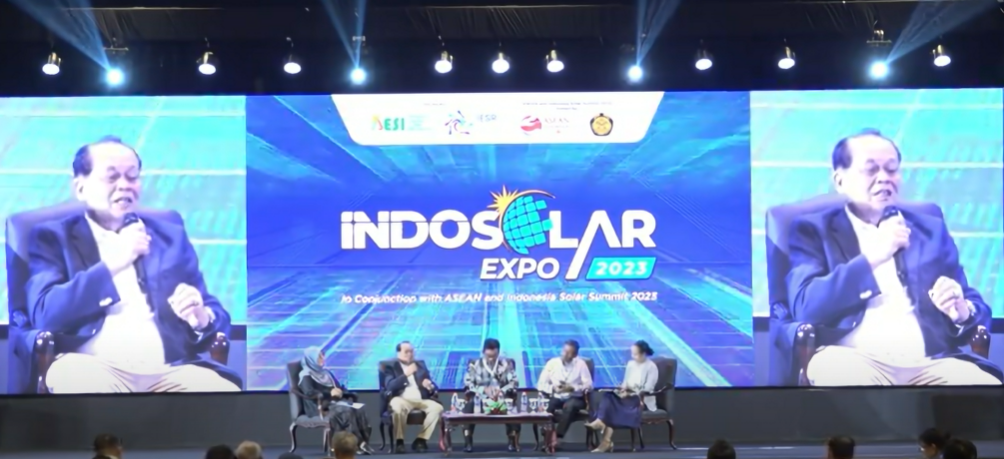Jakarta, July 26, 2023 – Solar energy must be accelerated to achieve a renewable energy mix of 23% by 2025 and reach net zero emissions by 2060 or earlier. Unfortunately, renewable energy had only made up approximately 12.3% of the national energy mix by 2022.
Director of Various New Energy and Renewable Energy, Directorate General of EBTKE, Ministry of Energy and Mineral Resources (ESDM) Andriah Feby Misna explained various programs are continuously being encouraged to utilize solar energy. Whether through a large-scale solar power plant (solar PV) program, floating solar PV, or rooftop solar PV. From a regulatory standpoint, said Feby, the revision to Minister of Energy and Mineral Resources Regulation No. 26 of 2021 concerning Rooftop Solar PV Connected to the Electric Power Network Holders of Business Licenses to Provide Electricity for Public Interest (IUPTLU) has been harmonized by the Ministry of Law and Human Rights.
“We have harmonized the revised ESDM Regulation 26/2021 with the Ministry of Law and Human Rights. Hopefully, it can be enacted shortly. Some of the content that has been changed in the revision of the Minister of Energy and Mineral Resources 26/2021 includes the provisions on the capacity that may be installed; in this revision, we do not limit the capacity they can install but must follow the existing quota. So as long as the quota exists, regardless of capacity demand, it must be met according to the existing quota,” said Feby in a panel discussion entitled “Solar regulations, implementation, plans” at the Indonesia Solar Summit event organized by the Ministry of Energy and Mineral Resources together with IESR.
In addition, Feby mentioned, the revision of the ESDM Permen also regulates changes related to exports and imports. Considering that currently, PLN is experiencing a surplus and PLN’s limitations in being able to accept intermittent generators, for this reason, there is no change to this Ministerial Regulation for exports. It remains connected to PLN, but when there are exports, this does not count as a reduction in consumer bills.
“With no export-import recognition in the revised ESDM Permen 26/2021, it is not interesting, but at least the current regulation opens an opportunity for the industry to be interested in installing rooftop PLTS because this is indeed market demand. In the future, the revision of this Ministerial Regulation will be reviewed again and can open up exports and imports again,” said Feby.
Member of the National Energy Council, Herman Darnel Ibrahim, criticized the contents of the revised ESDM Ministerial Regulation 26/2021 which removed the rules for exporting electricity to PLN. According to Herman, this shows Indonesia’s step towards the world where it will not develop a rooftop PLTS, even though the potential is enormous and there is no land lease.
“The projection is that solar energy will be the main one in the electricity sector. Solar energy figures (in the latest national energy policy (KEN)-red) are projected in 2060 to be around 500-600 GW. In the old national energy policy (KEN) in 2050 (solar energy-ed) 120 GW, but the realization is not fast enough,” said Herman.
Norman Ginting, Director of Projects and Operations of Pertamina New & Renewable Energy (Pertamina NRE) explained his party is committed to supporting the government to achieve the net zero emission (NZE) target in 2060 or sooner. One of these efforts is to start building a portfolio in solar energy, including solar cell technology.
“We have completed more than 50 megawatts of PLTS, one of which is the largest internal Pertamina Hulu Rokan with a total planned installed capacity of 25 megawatts. In addition, Pertamina has a great interest in how to run and implement green hydrogen from solar power because we see that green hydrogen is easier in the shifting process,” said Norman.
Furthermore, Norman highlighted that society and industry have been waiting for electricity based on renewable energy. Opportunities for developing solar PV are extensive, both on-grid and off-grid. For this reason, his party needs even more massive support in developing solar energy in Indonesia.
Ashwin Balasubramanian, Associate Partner of McKinsey stated that solar energy’s technical potential is significant, more than 3000 GW. The projection is that more than 400 GW will need to be built in 30-40 years. This is also a great investment opportunity and contributes to the gross domestic product (GDP) by opening up new jobs.
“If we look at Vietnam and Thailand, they have developed 10-15 times. India developed more than 16 GW. It shows it is possible with the right conditions and aspirations,” said Ashwin.

